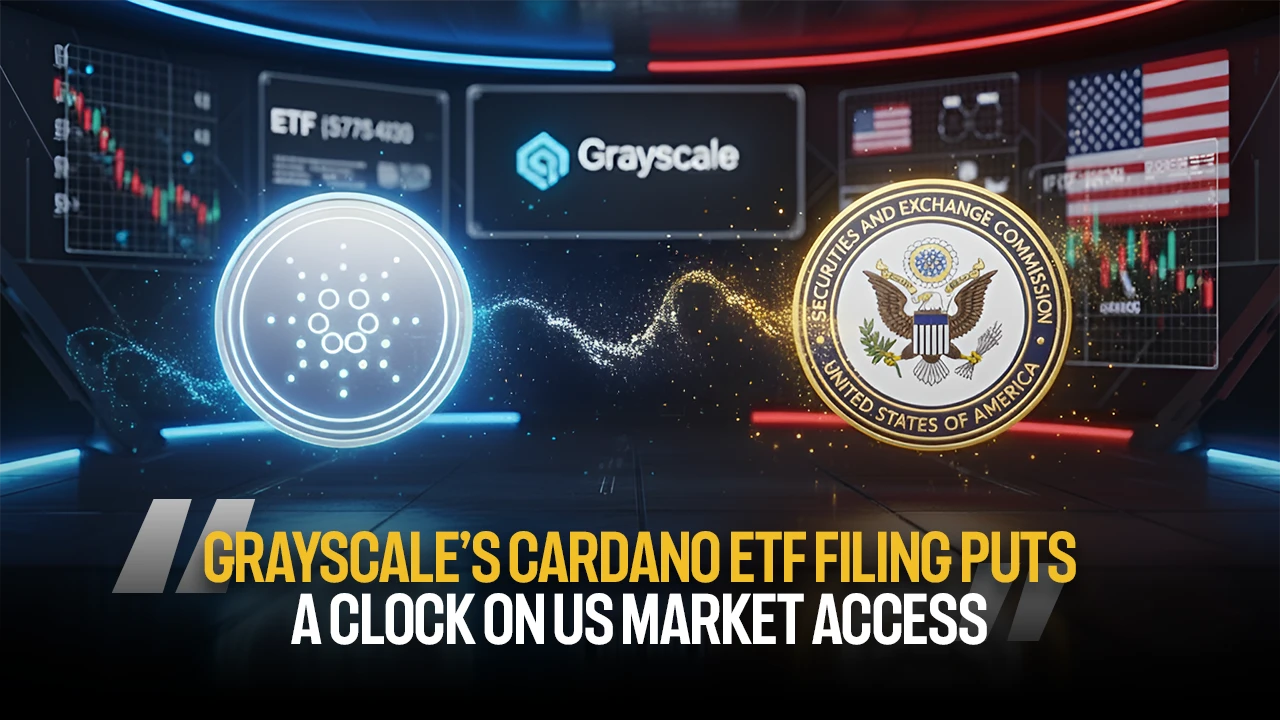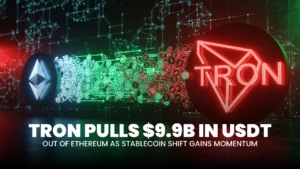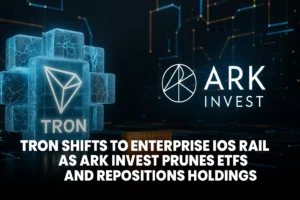Cardano Throws Governance, Cross-Chain Swaps Into the Ring Ahead of ETF Deadline

Cardano enters October with two storylines that matter to investors. Governance has shifted fully on-chain, and a new cross-chain link now allows ADA to move without bridges. At the same time, Grayscale’s Cardano Trust has an S-1 on file with the US SEC, putting a clear regulatory clock on the horizon.
- On-Chain Governance Changes How Work Gets Done
- Cross-Chain Without Bridges Lands Through NEAR Intents
- An ETF Filing Puts a Date on Market Access
- What the Network Data Says Right Now
- Market Response
- Cardano Signals to Track
- Conclusion
- Frequently Asked Questions About Cardano Readies Cross-Chain Push
- How is Cardano’s governance now different?
- Does Cardano use DPoS?
- What changed with NEAR Intents for ADA holders?
- What is the status of an ADA ETF in the US?
- Are ecosystem metrics improving?
- Glossary of Key Terms
The combination draws fresh attention to Cardano’s Delegated Proof of Stake (DPoS) model, where holders route influence through representatives to secure the network and guide governance. This design, long cited for balancing efficiency with broad participation, now sits at the center of how liquidity and decision-making scale together.
Headlines will continue to drive short-term price swings. The deeper question is whether Cardano’s design, community, and expanding toolkit can translate into real usage, deeper liquidity, and easier institutional access. This feature examines the three main levers that will answer that: governance, cross-chain execution, and regulated market access through ETFs. It also sets out what professionals should watch in the weeks ahead.
ALSO READ: Circle Deploys USDC and CCTP V2 on XDC Network to Simplify Cross-Border Payments
On-Chain Governance Changes How Work Gets Done
Cardano’s Chang upgrade moved the network into the Conway ledger era, adding on-chain voting and roles for a constitutional committee, stake-pool operators, and delegated representatives. Intersect, the membership group coordinating governance, describes the staged path from Chang #1 to the Plomin hard fork and the move out of bootstrap.
This turns debate into code and votes, which shortens feedback loops between proposals and outcomes. For investors, the signal is that parameters, funding, and roadmap can now be updated through a transparent, predictable process.
Intersect’s ongoing updates and elections underscore that this is not a slogan, it is a process with schedules and artifacts. Weekly bulletins and development notes document budgets, readiness, and committee activity.
That cadence matters to allocators who track execution risk. A network that runs changes through public proposals and votes reduces governance opacity, a frequent discount on emerging-tech assets.
The Intersect weekly development update is out! What’s new at Intersect? This week, we cover:
🏛️Cardano Constitution
📊Cardano budget
⚙️Chang# 2 update
🔧Community and Governance tooling
➕more…
➡️https://t.co/ANuwe0lE1u#Cardarno #Cardanocommunity pic.twitter.com/6YJDqdBpXq— Intersect (@IntersectMBO) November 15, 2024
Cardano’s delegation-centric model, functionally similar to DPoS in the way holders can route voting power to representatives, aims to keep participation broad while avoiding validator concentration. In practice, the test will be voter turnout and whether DReps reflect real constituencies. If they do, governance can speed reviews of fee, block, and script parameters that affect builder experience and app margins.
Cross-Chain Without Bridges Lands Through NEAR Intents
The most concrete interoperability change is live. NEAR Protocol announced that Cardano integrates with its Intents layer, enabling bridgeless swaps of ADA across more than 20 chains and over 100 assets. Charles Hoskinson endorsed the work, calling intents “the future of crypto.” For users and desks, that removes a common operational choke point: bridges introduce additional trust and latency, whereas intent-based execution lets agents route orders across venues under one instruction.
“Glad to be working with NEAR. They are a great team and intents are the future of crypto.”
Glad to be working with NEAR. They are a great team and intents are the future of crypto https://t.co/ZabMUmGe0Y
— Charles Hoskinson (@IOHK_Charles) September 30, 2025
“Cardano x NEAR Intents is LIVE. Swap ADA across 20+ chains and 100+ assets.”
🚨 Cardano x NEAR Intents is LIVE 🚨
Swap $ADA across 20+ chains and 100+ assets such as, $BTC, $ETH, $SOL, $USDC, $USDT, and more
⛓️ No bridges
🧠 AI-ready
💡 Privacy-first infra
🌐 Powered by NEAR Intents pic.twitter.com/hbOIhXrPAd— NEAR Protocol (@NEARProtocol) September 30, 2025
The integration sits alongside Cardano’s scaling work. The Hydra and Mithril teams continue to ship, with the latest Mithril distribution supporting node updates and improving client tooling, and ongoing work on parameter decentralization and SNARK-friendly succinct proofs.
Those details matter because cross-chain flow increases load in bursts. Faster snapshots, lighter proofs, and better chain-follow behavior reduce tail risk when liquidity spikes.
Cardano’s approach to staking and delegation, akin to a DPoS-style social layer over Ouroboros, benefits from this cross-chain push. If ADA can move and settle with fewer intermediaries, more holders can stake and still access liquidity, which supports security and yield without heavy custody friction. That link between access and participation is the architecture bet Cardano has made since launch.
An ETF Filing Puts a Date on Market Access
The path to a US ADA ETF is no longer hypothetical. Grayscale filed an S-1 for the Grayscale Cardano Trust ETF in August. The submission names the product, structure, and intent to list shares representing ADA held by the trust.
The separate exchange rulemaking to list and trade shares is a distinct step, but the existence of the S-1 anchors timelines for the decision process. Markets will watch for amendments, comment periods, and any exchange proposals tied to the listing venue.
More broadly, the US regulator has recently approved spot products for bitcoin and ether, and has considered generic listing standards for commodity-based ETPs. Those precedents do not guarantee approval for ADA, yet they frame the type of surveillance, custody, and pricing questions the SEC will ask.
For allocators, an ADA ETF would remove onboarding and custody friction in mandates that cannot hold tokens directly. That can increase addressable demand, improve liquidity at the open and close, and tighten spreads. It would not change fundamentals overnight, but it would change who can participate.
What the Network Data Says Right Now
Ecosystem figures give a mixed picture. Essential Cardano’s latest weekly development update lists about 2,009 projects being built, 1.34 million delegated wallets, and roughly 10.90 million native tokens across more than 221,000 policies.
On DeFiLlama, Cardano’s TVL hovers in the low to mid-hundreds of millions, with recent snapshots near the $300–350 million range and daily DEX volumes around the low single-digit millions. These are not peak-cycle numbers, but they are durable through volatility, which suggests a base of committed users.
For a chain that prizes formal methods, consistency over peak throughput is the metric to track. Hydra and Mithril are specifically designed to shorten paths, make snapshots practical, and enable apps to recover faster when something goes wrong.
IOHK’s January note about exploring Bitcoin interoperability shows the team still thinking in systems terms, not single features. That orientation attracts a certain builder profile, patient and risk-aware, which can be an advantage when capital is selective.
Market Response
Professionals will frame Cardano’s next month in three linked questions.
First, does governance lower friction for parameter changes that matter to builders. If yes, expect steady gains in contract deployments, throughput, and user retention as the community iterates on fees and script performance. Intersect’s election calendar and weekly governance artifacts are the datasets to watch.
Second, does cross-chain flow convert to sticky liquidity. NEAR Intents eliminates bridges for ADA, but market makers will judge it on settlement reliability, failed-intent rates, and path quality during stress. If the path holds up, ADA can ride flows into stablecoins and majors without the usual bridge tax, which can lift DEX depth and lower spreads across the ecosystem. The presence of a delegation-based, DPoS-like voting layer can amplify the effect if more holders stake without sacrificing mobility.
Third, does the ETF process expand the buyer set. The answer depends on the SEC’s comfort with spot markets and custody controls for ADA. A listed product would not guarantee inflows, but it would give RIAs and funds a clean instrument to express views. Any exchange filings, surveillance-sharing agreements, and final S-1 amendments will be read line by line by desks ahead of any decision windows.
Cardano Signals to Track
| Metric | Latest context | Source |
| Governance status | Chang enacted, on-chain voting and roles active, Plomin hard fork completes bootstrap path | Cardano Docs (docs.cardano.org) |
| Cross-chain link | NEAR Intents live for ADA, bridgeless swaps across 20+ chains and 100+ assets | NEAR Protocol on X (X (formerly Twitter)) |
| Development cadence | Mithril 2537.0 supports node v10.5.1, client CLI stabilized, ARM binaries added | Intersect updates(updates.cardano.intersectmbo.org) |
| Ecosystem breadth | ~2,009 projects, ~1.34m delegated wallets, ~10.90m native tokens | Essential Cardano weekly (Essential Cardano) |
| DeFi baseline | TVL in ~$300–350m band, DEX volume low millions daily | DeFiLlama: Cardano (DeFi Llama) |
| ETF process | Grayscale Cardano Trust ETF S-1 filed, listing rule process separate | SEC EDGAR S-1 (SEC) |
A note on tone and risk: IOHK framed its 2025 plan as exploring Cardano as a smart-contract layer for Bitcoin. The company wrote that it would evaluate merged-mining-adjacent designs and agent-driven interoperability, which dovetails with the intended direction.
That is not a guarantee; it is a research vector. Investors should monitor how quickly research translates into production code and integrations that touch balances, because that is where usage gets sticky.
Conclusion
Cardano is shipping what matters. Governance is now a machine that can iterate parameters and budgets with votes on-chain. NEAR Intents makes ADA portable without bridges, a practical step that users and market makers can test today. The Grayscale S-1 filing sets an external clock on market access in the US, even as rules and surveillance questions remain.
Through it all, Cardano’s Delegated Proof of Stake or DPoS-style participation model attempts to balance security, voter reach, and throughput, a design that pays off only if users show up and stay. The next few weeks will show whether governance cadence, cross-chain execution, and ETF headlines combine into deeper liquidity and steadier usage, or whether Cardano remains a high-integrity chain waiting for a broader wave to lift it.
Frequently Asked Questions About Cardano Readies Cross-Chain Push
How is Cardano’s governance now different?
Voting and constitutional roles are on-chain. Stakeholders and delegates approve changes through transparent processes documented by Intersect and Cardano docs.
Does Cardano use DPoS?
Cardano runs Ouroboros proof-of-stake with delegation. It is not classic DPoS, but holders can delegate voting and staking, which functions like a DPoS-style social layer.
What changed with NEAR Intents for ADA holders?
Users can swap ADA across 20+ chains without bridges. Execution is intent-based, handled by solvers, which reduces friction and some bridge risks.
What is the status of an ADA ETF in the US?
Grayscale filed an S-1 for a Cardano Trust ETF. A separate exchange proposal would handle listing. The SEC’s review process dictates final timing.
Are ecosystem metrics improving?
Core metrics show stability, thousands of projects and over a million delegated wallets. DeFi TVL sits in the low-hundreds of millions, with modest DEX volumes.
Glossary of Key Terms
- Ouroboros: Cardano’s proof-of-stake protocol that secures the chain.
- Delegation: Assigning stake and voting power to a representative or pool.
- DReps: Delegated representatives who vote on governance actions.
- Chang: Upgrade that enabled on-chain governance in the Conway era.
- Plomin hard fork: The enactment stage that moved governance out of bootstrap.
- NEAR Intents: An intent-based system enabling bridgeless cross-chain swaps.
- Hydra: Layer-2 protocol designed to scale transaction throughput.
- Mithril: Snapshot and proof system that speeds node sync and recovery.
- S-1: US SEC registration statement for offering or listing a security.
- TVL: Total value locked in DeFi apps on a blockchain.




